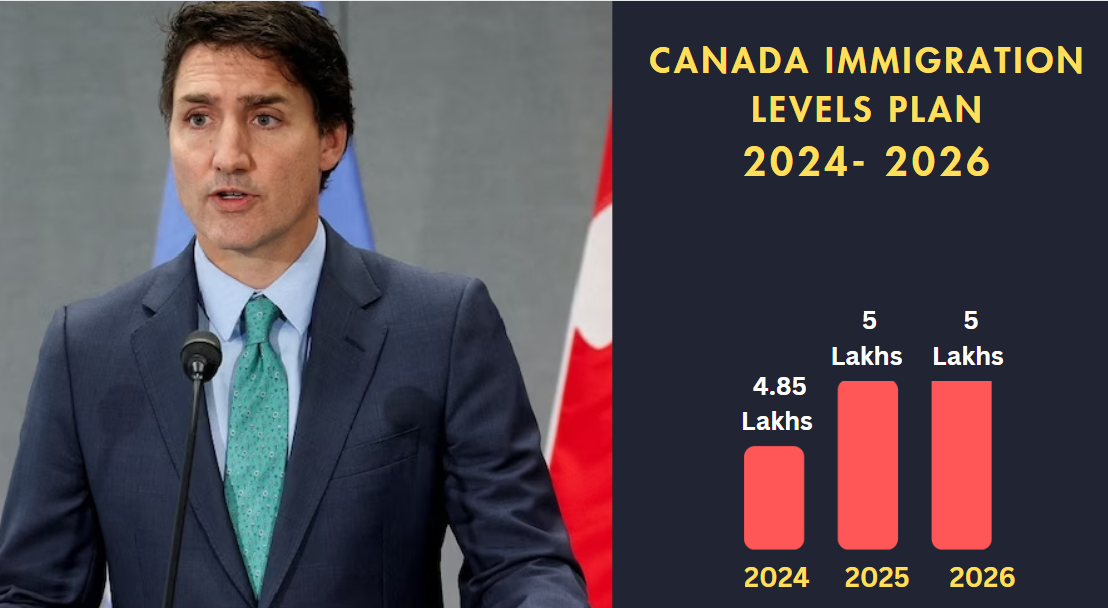Canada’s Immigration Levels Plan 2024-2026 addresses housing and healthcare
Immigration, Refugees, and Citizenship Canada (IRCC) issued the Immigration Levels Plan 2024-2026 on November 1st.
It establishes a target for the number of permanent residents admitted to Canada over the next three years.
Canada will welcome 485,000 new permanent residents in 2024, followed by 500,000 per year in 2024 and 2025.Immigration, Refugees, and Citizenship Canada (IRCC) issued the Immigration Levels Plan 2024-2026 on November 1st.
The strategy, according to Immigration Minister Marc Miller, will stabilize the amount of newcomers arriving in Canada, which has been a source of anxiety for many Canadians.
According to a recent Environics Institute report, Canadians are expressing less enthusiasm for increased levels of immigration than in past years. According to the research, individuals who had withdrew their support were concerned about house affordability in Canada.
Recognizing these concerns, the Minister states that the new plan would be comprehensive and will strive to strike a balance between Canada’s labour force needs and assuring the support of the country’s existing population.
“We recognize that housing, infrastructure planning, and long-term population growth must be properly considered,” he stated in an official statement. “Through this plan, we strike the proper balance to grow Canada’s economy while maintaining our humanitarian tradition, supporting Francophone immigration, and developing a more collaborative approach to levels planning with our partners.” Canada will continue to welcome newcomers and support them in their new lives.”
How will the levels plan benefit Canada’s workforce?
The Immigration Levels Plan for 2024-2026 was tabled on the same day that IRCC released a Strategic Immigration Program, a new study outlining the department’s revamped approach to immigration.
Supporting Canada’s labor force expansion is one of the report’s core pillars. To that goal, almost 60% of entrants over the next three years will arrive through economic immigration programs such as Express Entry, the Provincial Nominee Program, or other regional economic immigration schemes.
Canada will accept 281,135 economic immigrants in 2024, followed by 301,250 in both 2025 and 2026.
The new IRCC plan also incorporates a “whole of government” approach to immigration, in which IRCC engages with stakeholders, government departments, and partners such as provincial governments to better understand the skills required and the number of newcomers required to address the gaps.
This technique will also assist IRCC in determining if there is sufficient support for immigrants when they arrive.
Furthermore, the Strategic Program states that IRCC wants to collaborate with partners to increase international credential recognition, allowing more entrants to apply their abilities.
It also intends to raise awareness of financial support services, such as loans, to assist newcomers with the fees connected with the credential recognition process.
Canada’s healthcare and construction
When the IRCC issued the levels plan, it also stated that bringing in a large number of immigrants to fill labour market needs will assist Canada in meeting its National Housing Strategy. The Housing Strategy seeks to invest more than $82 billion over the next ten years in order to develop more houses in Canada, lowering costs. More skilled people in construction and trades will be required.
People in Canada are also concerned about the country’s healthcare system. According to Statistics Canada, there were 136,000 people receiving healthcare and social assistance as of August 2023.
During the COVID-19 pandemic, numerous healthcare personnel were frequently compelled to work overtime without a break, putting a strain on the healthcare system. This resulted in burnout, and some healthcare professionals decided to change careers.
Furthermore, up to nine million Canadians are expected to retire by 2030, putting additional strain on the system as the country’s population ages.
According to Census 2021 data, more over 468,000 immigrants work in health-related occupations, however this is insufficient to satisfy all job vacancies.
According to the Levels Plan, Canada will admit 110,770 Express Entry candidates in 2024, and 117,500 in both 2025 and 2026.
#Canada permanent residence
#Express Entry
#immigrate to Canada
#immigration levels plan
#IRCC
#Marc Miller


